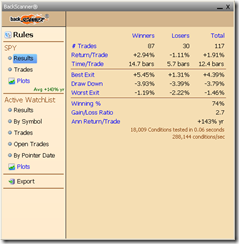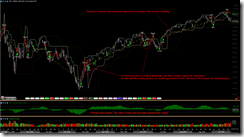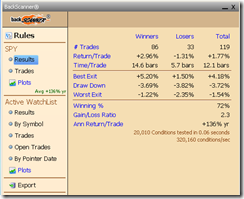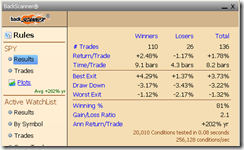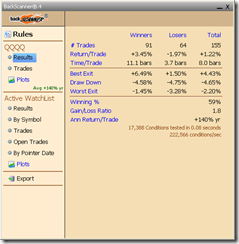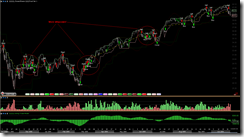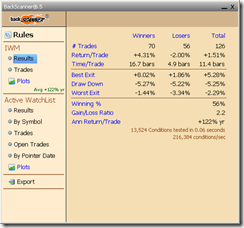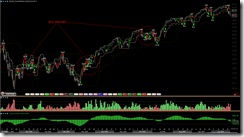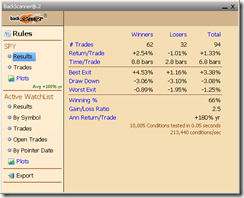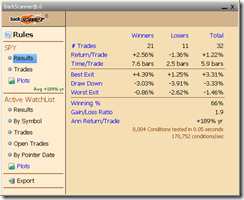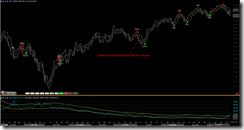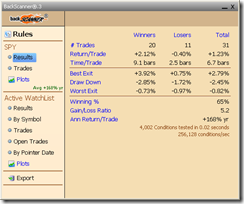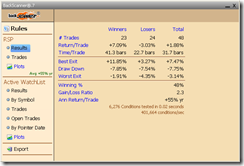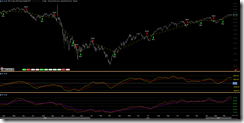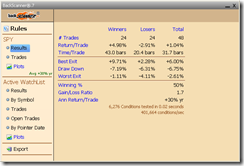As you've noticed, I'm gradually incorporating a few mechanical trading signals as the supplement for my daily report. TREAT THEM AS A FUN STUFF, as they're by no means scientific models which are optimized over and over by elite groups, they are simply simulate what I may act on certain market conditions.
There's no perfect model, so my main idea is to have several additional setups each giving signals on different timing on different method with different stop loss so in this way if one signal goes wrong then the others may well compensate the loss of the wrong one. The key is to allocate the fund properly. Simply following one or two setups without a proper risk management will result in losing money no matter how accurate the setup is. As you can see that the winning rate for most setups listed below are just above 50% – meaning for every two trades, there could be one losing trade. What really makes differences are gain/loss ratio which are all above 2, meaning you can afford to loss 2 trades for winning just 1 trade, as long as you EQUALLY put your fund in each trade.
Oh, one more thing: Although the SPY Swing Trade Model is optimized for SPY but it could apply to DIA/SPY/QQQQ/IWM and their leveraged fund such as DDM/SSO/QLD/UWM/BGU/TNA etc etc.
*All test summary posted below are tested since 2002.
SPY SWING TRADE MODEL
This is my major model. All the other setups use this Model (Except the NYMO Sell Setup) as the pre-determined trend context. i.e. When SPY Swing Trade Model is “long” signal, the other setups will not generate any “short” signals, in stead they focus only in buying dips.
The latest performance on 06/20/2010 before I started the improvement project.
07/25/2010: Here is the most recent improvement!
Although theoretically the SPY Swing Trade Model applies to QQQQ and IWM (and their correspondent leveraged ETF fund such as QLD and UWM), but I do have models specifically designed for each of them. These models have far more whipsaws, so generally, I’m not very confident about them and therefore they won’t be part of my daily market recap.
REVERSAL BAR SETUP
This setup uses a tighter stop loss so it’s a good short-term trade. If at the same time you own the swing trade position by following the swing trade model mentioned above, this setup can be used to fine tuning times for adding into the current existing swing trade position.
This is a well known setup. The idea is here: 6.2.0a VIX Trading Signals (ENV) and 6.2.0b VIX Trading Signals (ENV). Just the original idea of using ENV(10,10) works very bad, so I have adjusted the ENV(10,10) to ENV(22,10) and to use long setup only when swing trade model is long and short setup only when swing trade model is short. And since the ENV22 is an optimized number which may not work in the future, so frankly, I don’t like this setup. The setup is used as a supplement for the REVERSAL BAR SETUP, because sometimes there’s no reversal bar prior to the trend change.
NYMO SELL SETUP
The original idea is here: 6.4.0 SPX and NYMO Divergence Watch. This setup is designed to catch the “TOP”. It’s always very risky to catch either TOP or BOTTOM, but with a good well tested setup, sometimes the rewards are substantial. See the test summary below, the Gain/Loss Ratio is 5.2 which is very impressive.
The swing trade model is basically a trend following system so like all the trend following system, it too has lagging problem which means inevitably it will loss quite a lot profits when trend changes. By using this setup, it can protect the profits earned by the swing trade model and allowing smooth transition from long to short. Basically, whenever the setup is triggered but the swing trade model hasn’t told you to sell yet, you can then buy the bearish ETF while at the same time hold the swing trade position (which usually is a bullish ETF). If the setup is correct then the bearish ETF should well compensate the loss of your swing trade position while you’re waiting for the swing trade model yelling to sell (which as discussed above is always lagging).
Non-Stop
This model is suitable for investors by investing in equal weighted S&P 500 ETF (RSP). No stop loss is used simply either long or short, the average annual return could be around 15% ( back tested since 2004. 48 * 1.88 / ( 48 * 31.7 ) * 260 = 15.42% ). From the back test summary below, yes, the winning rate is not good but actually if you can take partial profits in the middle then the winning rate could be much higher as the absolutely failed trades (means from the very beginning to the end there’s no descent profits) are a little rare (13 absolutely failed trades out of total 24 failed trades).
If using SPY then the average annual return is around 8%.
More setups to be added. They will be back tested to make sure at least they worked well in the past…

